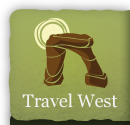History Of Zion National Park
Until 1908 when a federal land survey was conducted, few people - mainly Native Americans and early Mormon pioneers - had the privilege to see the beautiful area that is now Zion National Park. The surveyors were so enamored by the land that they informed President William Howard Taft about this precious area, and he classified more than 15,000 acres in the main canyon as Mukuntuweap National Monument in 1909. Since the national monument was relatively unknown and hard to access, Mukuntuweap received less than 1,000 visitors. Many early visitors complained that the undeveloped roads to the park hindered their efforts and most likely stifled many people's desire to visit the area despite its majestic scenery, flora, and fauna. These observations and concerns coupled with several informal federal reports helped catalyze the creation of the National Parks Service in 1916.
After the creation the National Parks System, Mukuntuweap really burgeoned, and by March 1918 the monument grew to over 75,000 acres and changed its named to Zion. In November 1919 Zion National Monument changed to Zion National Park. Despite this evolution few visitors still ventured the difficult way to visit the park. At this time, Stephen Mather was the National Parks Service director, and he was awed by the grandeur of Zion, which inspired him to visit here at least once annually from 1919 to 1929. During his visits, Mather typically brought prominent individuals along on his annual pilgrimage. For example, in 1921 a writer from the Saturday Evening Post and a famous naturalist accompanied Mather to Zion. The three began discussing a tourist circle during a trip to the North Rim of the Grand Canyon National Park. The tourist circle, now known as the Grand Circle, takes visitors from the North Rim of the Grand Canyon to Bryce Canyon National Park, Cedar Breaks National Monument, and Zion Canyon.
To increase the accessibility and popularity of Zion National Park Mather began working with local several communities to collaborate of developing paved roads. One of his major accomplishments was getting a 5,613 foot tunnel built through the sandstone cliffs of Zion Canyon. This tunnel enabled the construction of the Zion/Mt. Carmel Tunnel that created a viable roadway used to tour the Grand Circle. In addition to this infrastructure development, he teamed up with a local photographer who took and colorized photographs of Zion Canyon to advertise the national park.
Along with Mather's endeavors to increase accessibility to the area, the Union Pacific Railroad created a subsidiary Utah Parks Company to build tracks in the Southern Utah and Northern Arizona area. It eventually spent more than $1.7 million to improve the Zion National Park region. Some of these improvements included laying a railroad track to Cedar City and constructing a railway station, purchasing extensive advertising in popular magazines and creating a bus-touring service that transported visitors from Cedar City to the park as well as the other stops along the Grand Circle. 
Today, Zion National Park receives over three million visitors annually and now provides park shuttles from several locations within Zion Canyon and the local town of Springdale. The park has many trails that are suitable for hikers of all ages and fitness levels -- many of which are intermediate and expert hiking trails. Zion National Park is also very popular among rock climbers and canyoneers.
The Mukuntuweap campground is located within Zion Canyon. Local communities offer many camping, lodging and dinning choices as well as a host of evening entertainment options.
Did you like this page? Did you find it helpful? Please consider sharing.

